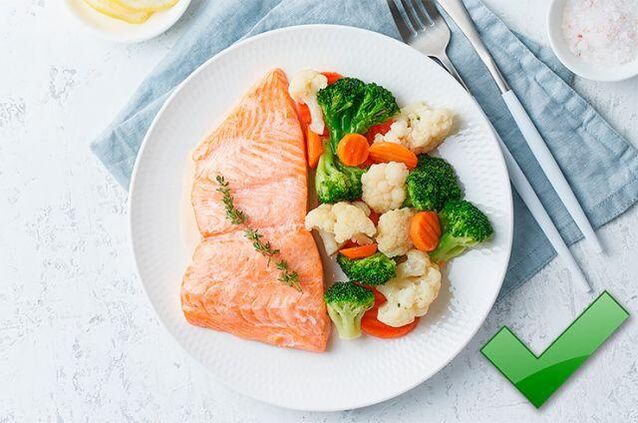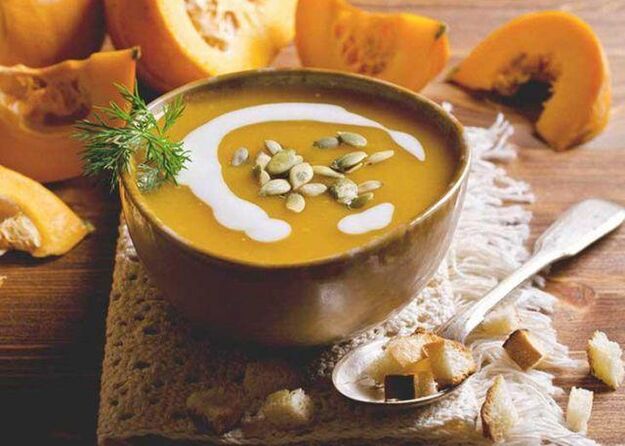
This unpleasant and even dangerous disease is considered the most common gastrointestinal disorder in modern humans. This is usually due to dietary violations, but the wrong product itself can cause it to develop. Diet for gastritis is as important as medication, and sometimes it's almost the only way to normalize the work of the gastrointestinal tract and prevent the disease from progressing to more dangerous and/or painful forms.
what is gastritis
Gastritis is an inflammatory process that develops on the gastric mucosa. Due to its improper function, the digestive process is disrupted, various negative effects occur, and the mucous membrane itself gradually thins.
The cause of this disease can be many different factors that are not new to the modern, constantly busy person. Hurrying with meals, poor grasping and chewing of hot or cold food, eating poor or harmful food, fast food, fatty, salty and unlimited smoking, systemic eating disorders - all of which can lead to gastritis. In addition, insufficient protein and vitamin content in food, long-term use of certain medications, constant stress, smoking, and inadvertently excessive alcohol consumption are also risk factors.
Nutritional rules for gastritis
Proper tissue nutrition plays a huge role in the treatment of this disease. It is important to know the rules and follow all the ins and outs of a high or low acidity gastritis diet prepared by a doctor. You must follow some simple and clear rules:
- All food must be chewed thoroughly and not swallowed.
- It is recommended that you organize your routine and eat by the hour. Ideally, meals should be piecemeal and portion sizes should be small. It is best to eat 5-6 times, each 200-250 grams, rather than 3 times 500-600.
- Allow 2. 5-3 hours between meals, preferably the same interval if possible.
- Food should always be warm, neither hot nor cold. The wrong temperature can irritate the stomach lining, leading to more inflammation.
- You should stop eating raw food. Preferably heat treated, even vegetables and fruits.
Also, it is very important that the product is always fresh; cooking it for future gastritis is not advisable or even dangerous.
what to eat with gastritis

- Generally stale bread, baked goods and pastries.
- Boiled, steamed, boiled or roasted (without skins) vegetables.
- Ground-grain porridge made with milk or water (rice, oatmeal, semolina, buckwheat).
- Low-fat fish.
- No roast lean meats and poultry (chicken, turkey, rabbit, veal).
- Non-acidic fruits, their dishes (apples, bananas, pears).
- Low-fat milk and dairy products (up to 1. 5%).
- Vegetables and butter (no more than 20-30 grams per day).
- Pastila, cotton candy.
- Natural honey (40-50 g).
- Steamed eggs, as part of a dish or boiled (2 per day).
It is important for people with gastritis to adhere to the correct drinking regimen. Consume 1. 5-2 liters of fluids per day, including juices, preserves and even soups. Mineral water of appropriate composition recommended by a doctor is allowed.
gastritis what not to eat
- Bacon and sausage.
- Sausages and sausages.
- bake.
- Fatty meat and fish.
- Sour fruits and berries.
- beans.
- Unheated fresh vegetables.
- Preservation and pickles.
- Fat and yogurt products.
- Barley, millet, unmilled grains.
- Macaroni, pasta and vermicelli made from whole wheat flour.
- Fresh pastries and breads.
- mushroom.
- Nuts and seeds.
- Bitchy.
- Hot spices and sauces.
- Espresso, tea, carbonated drinks.
- Alcohol.
*The list of prohibited and permitted products may vary slightly depending on the type of gastritis, so it is best to contact your doctor in order to clarify the details.
Gastritis Diet 1: Principles and Sample Menu

This nutritional system is recommended for people with acute gastritis. A similar retention regimen is prescribed for people with gastric or duodenal ulcers. The principles and rules are the same as above. Also, doctors recommend reducing salt intake, as it not only retains fluids in the body, but also irritates the mucous membranes. The standard calorie content in this mode should not exceed 2800-3000 calories per day. Let's take a look at a sample menu of the day to get a deeper understanding of the problem:
- Breakfast: milk porridge, boiled eggs, evaporated milk tea.
- Snack: Baked sweet apples with honey or sugar.
- Lunch: Vegetable cream soup, steamed turkey meatballs or meatballs, milk mashed potatoes, non-acidic fruit mousse.
- Snacks: croutons, rosehip soup.
- Dinner: Stew, fish, milk baked, milk tea.
- Bedtime snacks: bananas, milk.
Chronic gastritis diet
Dietary restriction is critical for patients when the disease progresses to a chronic form. By dieting, you can prevent flare-ups of disease and significantly improve your quality of life. Menus may vary slightly for different acidity levels, so it's worth discussing each case individually.
Nutrition for chronic gastritis with low acidity
The stomach begins to produce insufficient amounts of hydrochloric acid, and food is digested worse. The body cannot extract all the nutrients and trace elements it needs from it. Not only the mucous membranes of the organs themselves, but all systems of our body are affected by this.
dietary principles
- Puree, liquid and puréed dishes are best.
- Acceptable acidic food consumption.
- Eat small amounts of fried foods during remission.
- The temperature of the food can vary between +15-60°C.
- The total calorie intake of the daily diet should be suitable for 2500-3000 calories.
Permitted and Prohibited Products
For gastritis with low acidity, the menu is not difficult to write because it includes a wide variety of products. Meat, sausages, sausages and sausages, pastries and breads, fish, vegetables and fruits, and various grains are permitted. The menu may include juices, preserves, kisels, broths, tea and coffee, milk and lactic acid products.
However, there are some limitations, for example, you will have to give up foods that are too greasy. Goose, pork, salmon, fried doughnuts, creamy sweets and sweets should not be eaten. The vegetables eaten should not cause fermentation and flatulence, so it is best not to eat cabbage, beans, grapes, onions, garlic. Plain milk is also not recommended, but as part of a dish or as an additive to tea or coffee, it would be great.
Nutrition for chronic gastritis with high acidity

With this type of disease, the stomach begins to produce excess acid, which can "digest" the surrounding tissue, increasingly damaging the mucous membranes. Therefore, the menu should be more economical than the previous case.
dietary principles
- No spicy food. Anything that irritates the mucous membranes is immediately swept aside.
- Products must be completely low-fat.
- Fried foods are completely excluded, and all foods should be boiled, steamed or grilled.
- It is best to puree the product and wipe it off before use.
- Meals should be frequent and divided, and portions should be small.
- Daily salt intake can be increased to 8 grams.
- The daily calorie content should be in the range of 2200-2500 calories.
Permitted and Prohibited Products
The dietary goal for this disease is to keep the menu as small as possible, but at the same time as varied and nutritious. As with diet 1, you can only eat boiled, steamed, and roasted vegetables, and choose only non-acidic fruits. They also need to be boiled, preferably mashed. Lean meats and fish are allowed and also require careful grinding.
Sour milk with increased acidity is prohibited, but dairy products must be included in the diet. The porridge is cooked lightly, wipe it down if necessary, and use only light broth for the soup. It is best to refuse sauerkraut, borscht, cabbage soup, okra and other sauerkraut.
acute gastritis diet

Acute inflammation of the gastric mucosa is often accompanied by severe pain and nausea. This stage requires immediate medical examinations, lifestyle changes, and dietary changes. It's best to give up solid foods entirely, even mashed ones, on the first day, and limit yourself to warm water or weak tea.
By the next day, you can slowly eat the foods on your first diet list. Then you can prepare liquid, mushy or creamy soups, mashed low-fat fish or meat, hard-boiled eggs. Fresh vegetables and fruits and other products on the prohibited list should not be eaten.
erosive gastritis diet
This type of gastritis is dangerous precisely because ulcers form on the mucous membranes, which quickly turn into full-fledged ulcers. To stop symptoms and minimize negative consequences, you must strictly follow nutritional rules:
- There is no fried, salted or smoked food, all dishes are only boiled, steamed or grilled without a crust.
- 5-6 small divided meals per day. The maximum weight for a meal is 170-180 grams.
- Make it a habit to drink a glass of warm water before meals.
- Sauces, hot spices, mayonnaise, dishes with flavour enhancers are completely excluded.
- Eat slowly, chewing each bite thoroughly.
- All food should be served hot, not cold or hot.
The last meal should be set 2 hours before bedtime.
Atrophic gastritis diet
Diet for atrophic gastritis is the most important factor in the treatment process. Food is best taken at the same time on a regular basis. Otherwise, you will have to follow the same recommendations already made for Power System Table 1. You can consume all products on the allowed list and reject prohibited products.
Food can be eaten hot, pureed, steamed, boiled or grilled. Deep frying and fat, as well as sour, spicy and salty, are still banned. Tobacco and alcoholic beverages are considered the main enemies of all types of gastritis, so it is best to give them up forever to avoid acute symptoms.






























